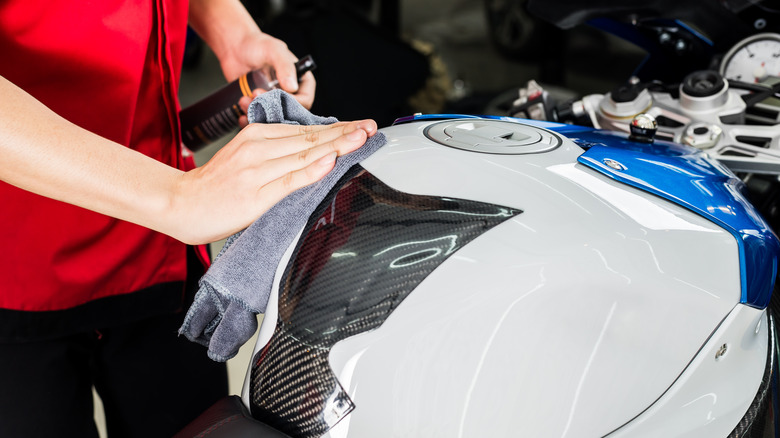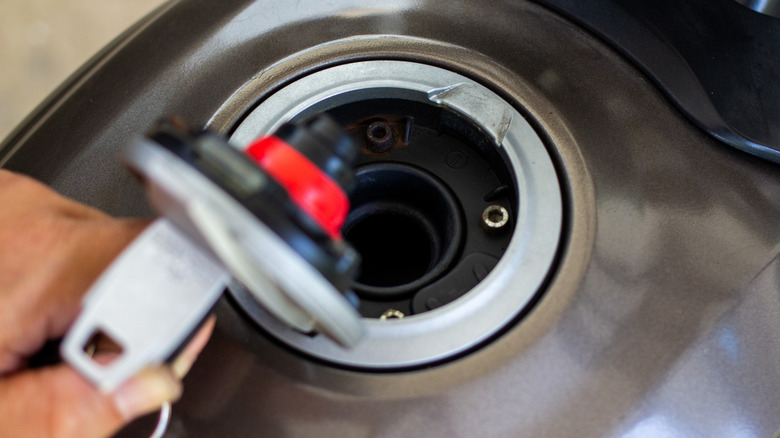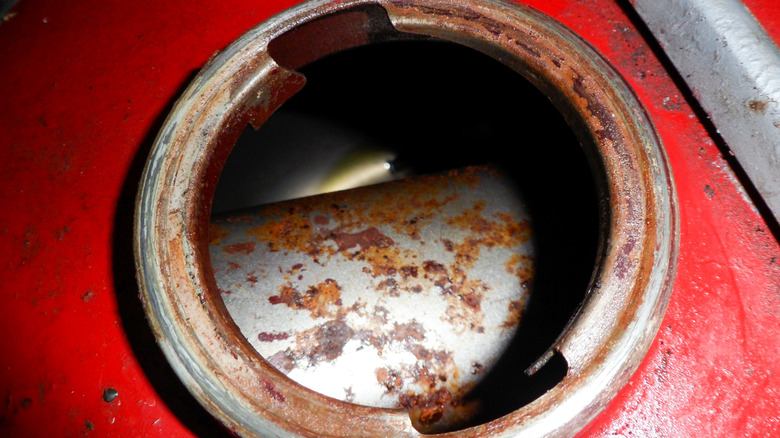How To Clean A Motorcycle Gas Tank
For some, riding a motorcycle down a wide open freeway is pretty much the epitome of freedom. We're certainly not here to rail against the unbridled majesty that purportedly accompanies charging down the open road astride a classic or modern build of your choice. However, we might simply point out that the version of ownership typically presented in pop culture often overlooks the fact that it does, in fact, take a lot of work to keep a motorcycle in proper working order. As is the case with any car, truck, or SUV you might park in your garage or driveway, properly washing your motorcycle can play in important part in not only keeping your bike looking good, but running good as well.
While you might be tempted to properly detail your motorcycle by focusing on items like chrome features, wheels and spokes, or engine components, more intricate tasks like cleaning and lubricating the chain should also be undertaken with some regularity. So too should be washing the vehicle's gas tank, as cleaning the chamber in and out can help prevent the damaging effects of rust and other forms of decay. Luckily, cleaning a motorcycle's gas tank is not a complicated process, and can likely be performed by owner's with little mechanical proficiency.
The task should be undertaken with great care, however, as a lackluster cleaning — particularly of the inside of a motorcycle's gas tank — may lead to even bigger problems. Here's how to clean a motorcycle and gas tank.
Cleaning the exterior of a motorcycle gas tank
We'll begin with cleaning the exterior of a motorcycle's gas tank, as it is undoubtedly the easier of the two tasks, and is generally performed anytime you set out to wash your bike. Assuming you know how to properly wash a vehicle, you might already have these cleaning tools in your garage. These include a bucket or two, a soft cleaning mitt, a hose or pressure washer, microfiber towels, and some sort of motorcycle-friendly cleaning agent. With those items in tow, follow these steps to wash your motorcycle.
- Plug the vehicle's exhaust holes, so water cannot enter.
- Hose down your motorcycle with clean water.
- Lather the surface of the bike — including the gas tank cover — with soapy water using a sponge, soft mitt, or microfiber towel.
- Fully rinse the soapy water from the vehicle.
- Use a microfiber towel or a chamois cloth to dry the surface.
It may be a good idea during the exterior cleaning to remove the gas cap and polish it up separately. Be sure not to allow water into the tank as you clean gunk and grime from both the top and bottom. As with an automobile, you can help seal and protect the paint job on your motorcycle gas tank by adding a layer of automobile wax after you wash the bike. Likewise, you can add another layer of protection by wrapping exposed parts of your bike like the gas tank, though there are some notable pros and cons to consider when it comes to wrapping.
Cleaning the interior of a motorcycle gas tank using acids
Now that you know how to get the exterior of your motorcycle gas tank clean, it's time to tackle the interior, which can be a hotbed for the of collection dirt, grime, and even rust when not properly cared for. The good news is that you can potentially prevent the build up of dirt, and even rust in a motorcycle's gas tank with occasional cleanings. For this task, it's recommended you remove the gas tank from your bike, as cleaning products may cause damage the motorcycle's fuel lines if allowed to enter. For this method, you'll need a common acid like Muriatic Acid or Phosphoric Acid, meaning you'll also need safety items like gloves, goggles, and a mouth-covering mask.
With those materials in hand, follow these steps:
- Unscrew or remove the gas cap.
- Empty any remaining fuel from the tank.
- Remove the tank's petcock and plug the hole.
- Use a light stream from a hose to loosen and remove excess dirt or rust. You can also fill the tank half way and shake it for a few moments.
- Drain the water and dry the interior using a fan or hose.
- Make a 50/50 solution of water and acid and pour it in the tank.
- Cover the gas cap hole and let stand for 15 minutes.
- Drain the solution completely, using a fan of hair dryer to dry the interior walls.
When working with acids, do so in a well ventilated area. While you've got that gas tank removed from your bike, consider giving the exterior a good cleaning with soap and water too, touching up any rust buildup that might be forming round the exterior openings.
Cleaning the interior of a gas tank using other methods
If you're not comfortable working with acids, there may be other, less perilous ways to help remove the buildup of dirt and even rust from your motorcycle's gas tank, with even WD-40 serving as an effective rust-removing agent. You can likely remove some dirt purely with a water and dishwasher mixture, using agitators such as nuts and bolts to loosen debris and excess rust buildup. You will, of course, need to ensure you do not leave items like nuts and bolts behind when you're finished cleaning if you use that method, as they could cause serious issues in the tank and fuel line thereafter.
Specific to rust, pouring an acidic such as vinegar into the tank and letting it soak for 24 hours may significantly reduce the level of corrosion and debris in the tank. Yes, baking soda can be added as an agitator in that scenario. This method though, requires that you drain the vinegar from the tank before adding a solution of water and baking soda, which will neutralize the residual acidity while removing additional rust. More information on this method can be found with a little online sleuthing if you're interested.
If you're looking to get more scientific about cleaning the dirt and rust from inside your motorcycle gas tank, you can reportedly even use electrolysis to do so. However, that method involves a MacGyver level of work that many may not be entirely comfortable with. Feel free to research the method on your own if you're interested. If, however, you have rust prevention on your mind, some believe covering the interior of the tank in a thin layer of diesel fuel may help future corrosion.



